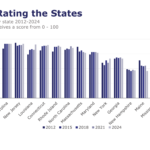It’s an exciting time in technology, and the rapid pace of innovation is inspiring, empowering and challenging the insurance industry.
Executive Summary
In 2015, insurers will leverage data accessibility, mobile, social media and platform migration to enable growth and optimize customer experience, says Novarica’s Martina Conlon.Technology mega-trends continue to offer great opportunities for insurers:
• Data, data and more data—Improved accessibility to internal data, the “Internet of things” and the explosion of data available from social media, telematics devices, sensors, satellites, wearables, mobile devices and traditional third-party data providers can be harnessed to drive improvements across the insurance value chain. Areas ripe for improvement include product development, customer service, underwriting, pricing, claims management and fraud avoidance. Powerful data storage technology and analytics tools can enable valuable insights that can deliver big benefits in each of these areas.
• Computing anywhere—Mobile empowers customers, agents and employees to conduct their business where, when and how they want. Insurers continue to be challenged to keep pace with consumer expectations set by banks, airlines and retail organizations.
• Social—Social media has opened new ways for insurers to communicate with customers, understand customer needs and re-enforce brand. Most insurers have mastered basic social media and will become more active in the space, but it’s probably going to be a while before insurers merge social media and e-commerce, as some leading retailers are doing.
• Platform shifts—Migration from mainframe to midrange systems to the cloud is enabling speed to market, reduced initial investment, and business and technology agility for many industries. Insurers have been busy transforming core systems to midrange platforms for the past 10 years but now are migrating ancillary systems (CRM, HRIS, financials) to the cloud even faster.
In 2015, insurers will leverage all of the above to enable growth, agility and optimal customer experience. These mega-trends in technology offer great opportunities for insurers to achieve strategic goals, but they also increase the challenge of prioritization. While many insurers would love to deploy leading-edge capabilities in these areas, many more are still dealing with foundation issues like antiquated core systems or inaccessible, poor-quality internal “little” data.
From recent research on 2015 insurer projects and priorities, we’ve found that the main theme of 2015 insurer IT investment is one of continuity.
• Most insurers plan modest budget increases. Overall average spending ratios are up slightly to 3.8 percent from 3.5 percent or 3.6 percent in previous years, but we regard this slight statistical increase as consistent with historical norms of 2-5 percent rather than evidence of a significant shift in resource allocation within the industry.
• Supporting growth continues to be the dominant strategic goal of insurance IT spending. Insurers are more likely to cite growth and operational effectiveness as the key drivers of their IT strategies rather than expense reduction or even competitive parity.
• Fewer than half of insurers are enthusiastic about their current capabilities. Insurers remain critical of their own technology-enabled capabilities, with the exception of financials and IT security. CRM and customer portal capabilities are widely acknowledged to be weak, and more than one-third of insurers believe their analytics capabilities are badly in need of improvement.
• Core policy admin remains the most active area for replacement.Nearly 40 percent of insurers are currently engaged in or are planning a policy administration system replacement in 2015.
• Business intelligence is the most active area for enhancement. While few insurers are shopping for new BI environments, more than half are planning major enhancements in reporting, data repositories and analytics capabilities.
Emerging areas continue to emerge, but slowly. While policy administration systems and business intelligence remain areas of continued investment and focus, most insurers are investing more limited amounts to dabble in social, mobile, big data and the cloud.
One very clear trend is that insurance IT budgets and projects change slowly from year to year. Almost half of the insurers surveyed are planning to work on the same top priority projects in 2015 as they were in 2014.
The continued increase in budgets, however modest, is cause for hope as insurers continue to devote resources to expanding and improving their capabilities. There is a noticeable disparity between insurers that invest heavily in their core systems to meet future demand for business capabilities and embrace the possibilities offered by emerging technology areas and those that continue to treat IT as a problem to be solved. We believe the former group will continue to have a competitive advantage over the latter in this industry for 2015 and beyond.





















 IBHS: Virginia Edges Florida Out of First Place in Building Code Adoption
IBHS: Virginia Edges Florida Out of First Place in Building Code Adoption  Fitch: U.S. Cyber Insurers Saw Strong Profits, Slowdown in Premium Growth in 2023
Fitch: U.S. Cyber Insurers Saw Strong Profits, Slowdown in Premium Growth in 2023  Going, Going, Gone: ‘Disruption’ to Shrink Traditional Premiums for Auto
Going, Going, Gone: ‘Disruption’ to Shrink Traditional Premiums for Auto  Time-Tested Loss Reserving Methods Challenged: AM Best
Time-Tested Loss Reserving Methods Challenged: AM Best 














